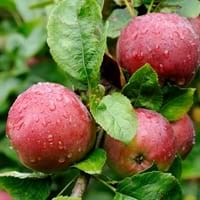Life Span
Perennial
Perennial
Origin
Eastern Asia
Eastern Europe, Southern Europe, Russia/Siberia, Southern Asia, Western Asia
Types
Actinidia arguta, Actinidia giraldii, Actinidia hypoleuca
not available
Number of Varieties
Not Available
Habitat
Dappled Shade, open Woodlands
Not Available
USDA Hardiness Zone
3-8
3-8
Sunset Zone
1a, 1b, 2a, 2b, 3a, 3b, 4, 5, 6, 7, 8, 9, 14, 15, 16, 17, 18, 19, 20
6, 7, 8, 9, 14, 15, 16
Habit
Vining/Climbing
Oval or Rounded
Flower Color
White, Ivory
White, Pink, Rose
Flower Color Modifier
Bicolor
Bicolor
Fruit Color
Green, Yellow green
Yellow, Red, Green, Gold, Pink, Dark Red
Leaf Color in Spring
Green, Dark Green
Green
Leaf Color in Summer
Dark Green
Green
Leaf Color in Fall
Dark Green
Green, Light Yellow, Brown
Leaf Color in Winter
Light Green
Light Green
Plant Season
Spring, Summer, Fall
Spring, Fall
Sunlight
Full Sun, Partial Sun
Full Sun, Partial Sun, Partial shade
Growth Rate
Medium
Medium
Type of Soil
Loam
Clay, Loam, Sand
The pH of Soil
Neutral
Acidic, Neutral
Soil Drainage
Well drained
Well drained
Bloom Time
Spring, Late Spring, Early Summer
Early Spring, Spring
Tolerances
Shade areas
Drought
Where to Plant?
Ground, Pot
Ground
How to Plant?
Grafting, Stem Cutting
Budding, Grafting
Plant Maintenance
Low
Medium
Watering Requirements
Average Water Needs, Requires regular watering
Requires regular watering
In Summer
Regular watering required
Lots of watering
In Spring
Moderate
Moderate
In Winter
Average Water
Average Water
Soil pH
Neutral
Acidic, Neutral
Soil Type
Loam
Clay, Loam, Sand
Soil Drainage Capacity
Well drained
Well drained
Sun Exposure
Full Sun, Partial Sun
Full Sun, Partial Sun, Partial shade
Pruning
Remove damaged leaves, Remove dead branches, Remove dead leaves
Remove damaged leaves, Remove dead branches, Remove dead leaves
Fertilizers
Apply 10-10-10 amount, fertilize twice a year
Requires high amount of nitrogen
Pests and Diseases
Botrytis head rot, Japanese Beetles, Leaf Rollers, Nematodes, Phytophthora, Root rot, Sclerotinia blight, Spider mites, Thripes
Aphids, codling moth, mussel scale, Red spider mite, woolly aphid
Plant Tolerance
Shade areas
Drought
Flower Petal Number
Single
Single
Foliage Texture
Medium
Medium
Foliage Sheen
Glossy
Matte
Attracts
Cats
Not Available
Allergy
Not Available
Not Available
Aesthetic Uses
Cottage Garden
Showy Purposes
Beauty Benefits
Not Available
Not Available
Environmental Uses
Shadow Tree
Air purification
Medicinal Uses
Antioxidants, Fiber, Folate, Rich in Potassium, Vitamin C
Alzheimer’s Disease, bowel syndrome, Cancer, constipation, Detoxifies lever, Diabetes, Diarrhea, gallstones, Healthy teeth, hemorrhoids, High cholestrol, Immunity, Improve heart health, Parkinson
Part of Plant Used
Fruits
Fruits, Leaves
Other Uses
Grown for shade
Used As Food, Used for its medicinal properties
Used As Indoor Plant
No
No
Used As Outdoor Plant
Yes
Yes
Garden Design
Edible, Feature Plant, Vine
Edible, Feature Plant, Fruit / Fruit Tree
Botanical Name
ACTINIDIA arguta
MALUS domestica 'Royal Gala'
Common Name
Hardy Kiwi
Apple, Eating Apple, Royal Gala Apple
In Hindi
हार्डी कीवी
Royal Gala Apple
In German
Hardy Kiwi
Royal Gala Apfel
In French
kiwai
Royal Gala d'Apple
In Spanish
kiwi hardy
Manzana Royal Gala
In Greek
σκληραγωγημένα ακτινίδια
Royal Gala της Apple
In Portuguese
kiwi Hardy
Maçã Royal Gala
In Polish
hardy kiwi
Royal Gala jabłko
In Latin
Hardy kiwi
Regia Schola Apple
Phylum
Magnoliophyta
Magnoliophyta
Class
Magnoliopsida
Eudicotyledones
Family
Actinidiaceae
Rosaceae
Genus
Actinidia
Not Available
Clade
Angiosperms, Asterids, Eudicots
Not Available
Tribe
Not Available
Not Available
Subfamily
Actinidiaceae
Not Available
Number of Species
Not Available
Not Available
Season and Care of Hardy Kiwi and Royal Gala Apple
Season and care of Hardy Kiwi and Royal Gala Apple is important to know. While considering everything about Hardy Kiwi and Royal Gala Apple Care, growing season is an essential factor. Hardy Kiwi season is Spring, Summer and Fall and Royal Gala Apple season is Spring, Summer and Fall. The type of soil for Hardy Kiwi is Loam and for Royal Gala Apple is Clay, Loam, Sand while the PH of soil for Hardy Kiwi is Neutral and for Royal Gala Apple is Acidic, Neutral.
Hardy Kiwi and Royal Gala Apple Physical Information
Hardy Kiwi and Royal Gala Apple physical information is very important for comparison. Hardy Kiwi height is 550.00 cm and width 90.00 cm whereas Royal Gala Apple height is 370.00 cm and width 460.00 cm. The color specification of Hardy Kiwi and Royal Gala Apple are as follows:
Hardy Kiwi flower color: White and Ivory
Hardy Kiwi leaf color: Green and Dark Green
Royal Gala Apple flower color: White, Pink and Rose
- Royal Gala Apple leaf color: Green
Care of Hardy Kiwi and Royal Gala Apple
Care of Hardy Kiwi and Royal Gala Apple include pruning, fertilizers, watering etc. Hardy Kiwi pruning is done Remove damaged leaves, Remove dead branches and Remove dead leaves and Royal Gala Apple pruning is done Remove damaged leaves, Remove dead branches and Remove dead leaves. In summer Hardy Kiwi needs Regular watering required and in winter, it needs Average Water. Whereas, in summer Royal Gala Apple needs Lots of watering and in winter, it needs Average Water.





